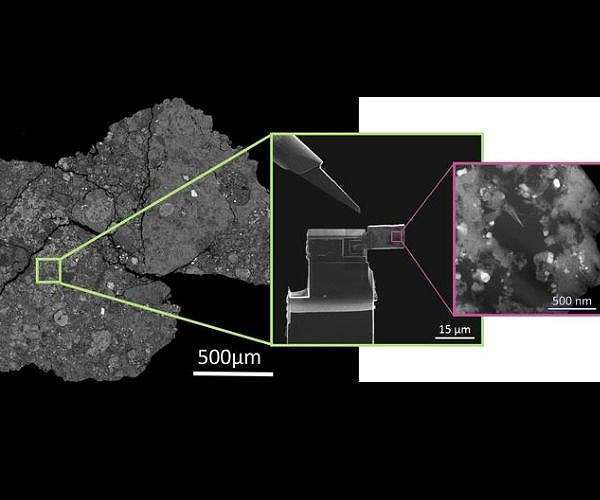6.02.2024

Using a nanomanipulator and an ultra-fine ion beam, a tiny lamella, about five by ten micrometres in size and only one hundred nanometres thin, is cut out of the meteorite and attached to a sample bar. The scientists can then analyze the organic particles in this lamella under an electron microscope (right).
The recent study conducted by Dr. Christian Vollmer and his team, in collaboration with British colleagues, marks a significant advancement in the field of astrobiology and planetary science. By examining the Winchcombe meteorite, a rare and quickly collected celestial visitor, they have achieved a groundbreaking feat in demonstrating the presence of key nitrogen compounds, including amino acids and heterocyclic hydrocarbons, without subjecting the sample to any chemical treatment.
This discovery, detailed in Nature Communications, sheds new light on the molecular precursors to life on Earth and offers a novel methodology for studying extraterrestrial materials.
Meteorites, such as the Winchcombe, are fragments of asteroids that journey to Earth, bringing with them secrets from the dawn of the solar system. The Winchcombe meteorite, observed falling in England in February 2021 and swiftly retrieved, provides an exceptionally well-preserved sample of cosmic sediment.
Unlike meteorites found in Earth's deserts, which undergo changes due to weathering, the Winchcombe's rapid collection preserved its pristine condition, making it an invaluable resource for research into the origins of our solar system and life itself.
The study of meteorites often requires the application of solvents or acids to extract and concentrate organic compounds for analysis. However, the innovative approach taken by Dr. Vollmer's team, utilizing a state-of-the-art, high-resolution electron microscope at the SuperSTEM laboratory in Daresbury, England, allows for the direct observation and chemical analysis of these compounds at atomic resolution. This method not only maintains the integrity of the delicate organic molecules but also bypasses the potential alterations that chemical treatments could cause.
The significance of this research extends beyond the academic sphere. It demonstrates that life's building blocks can be directly observed and analyzed in space-sent samples, paving the way for future studies of materials returned from space missions, such as the asteroid dust particles retrieved by the Hayabusa2 and OSIRIS-REx missions.
This methodological breakthrough could revolutionize our understanding of the distribution of organic compounds in the cosmos and their role in the emergence of life on Earth.
In conclusion, the discovery of biologically relevant nitrogen compounds in the untreated Winchcombe meteorite represents a pivotal moment in the quest to unravel the mysteries of life's origins. By leveraging advanced electron microscopy, researchers can now explore the primordial ingredients of life embedded in meteorites, offering new perspectives on the cosmic pathways that might have seeded life on our planet.
This research not only enriches our understanding of the universe but also highlights the potential for novel analytical techniques to illuminate the ancient processes that forged the building blocks of life across the stars.
Quelle: SD

